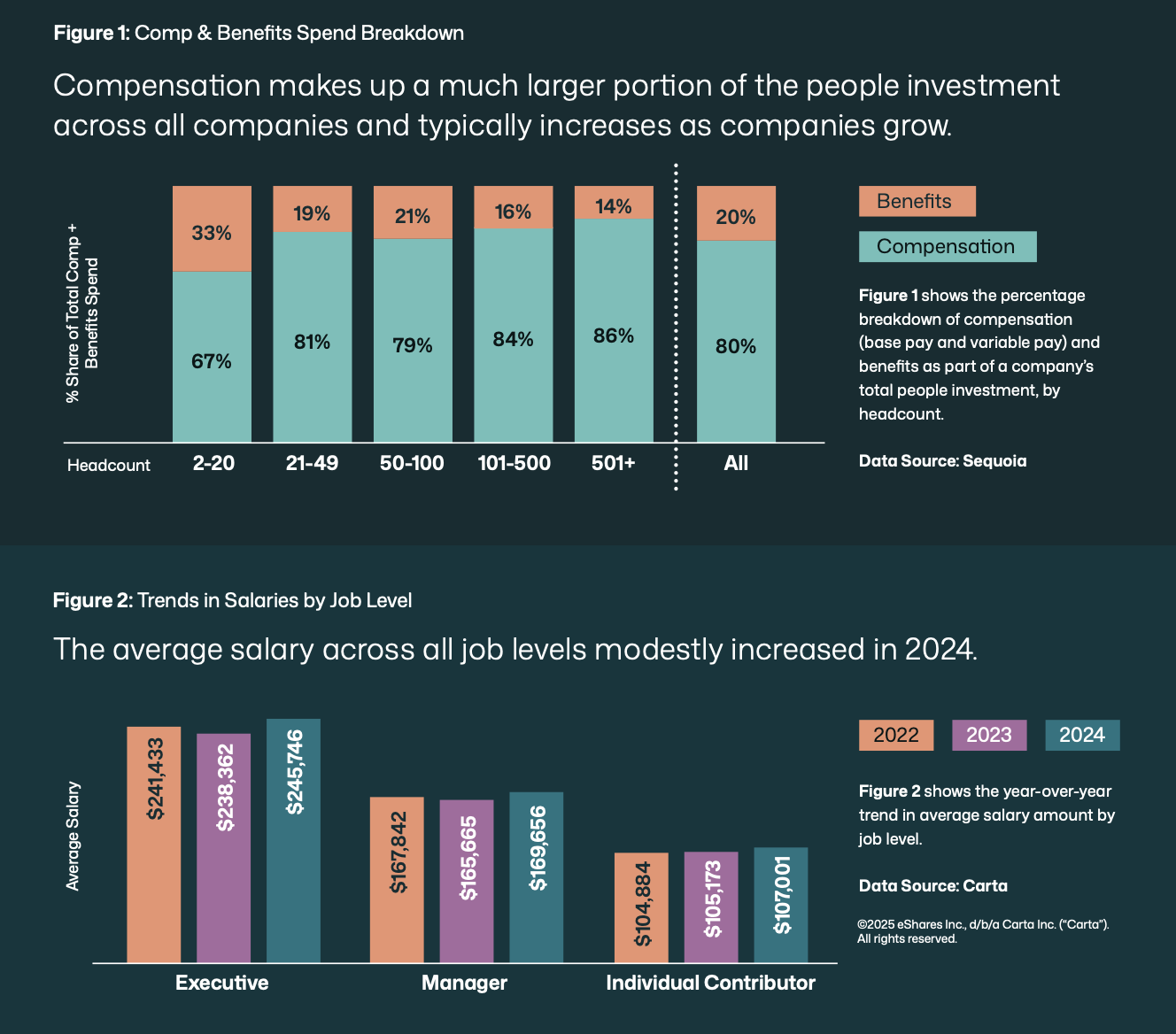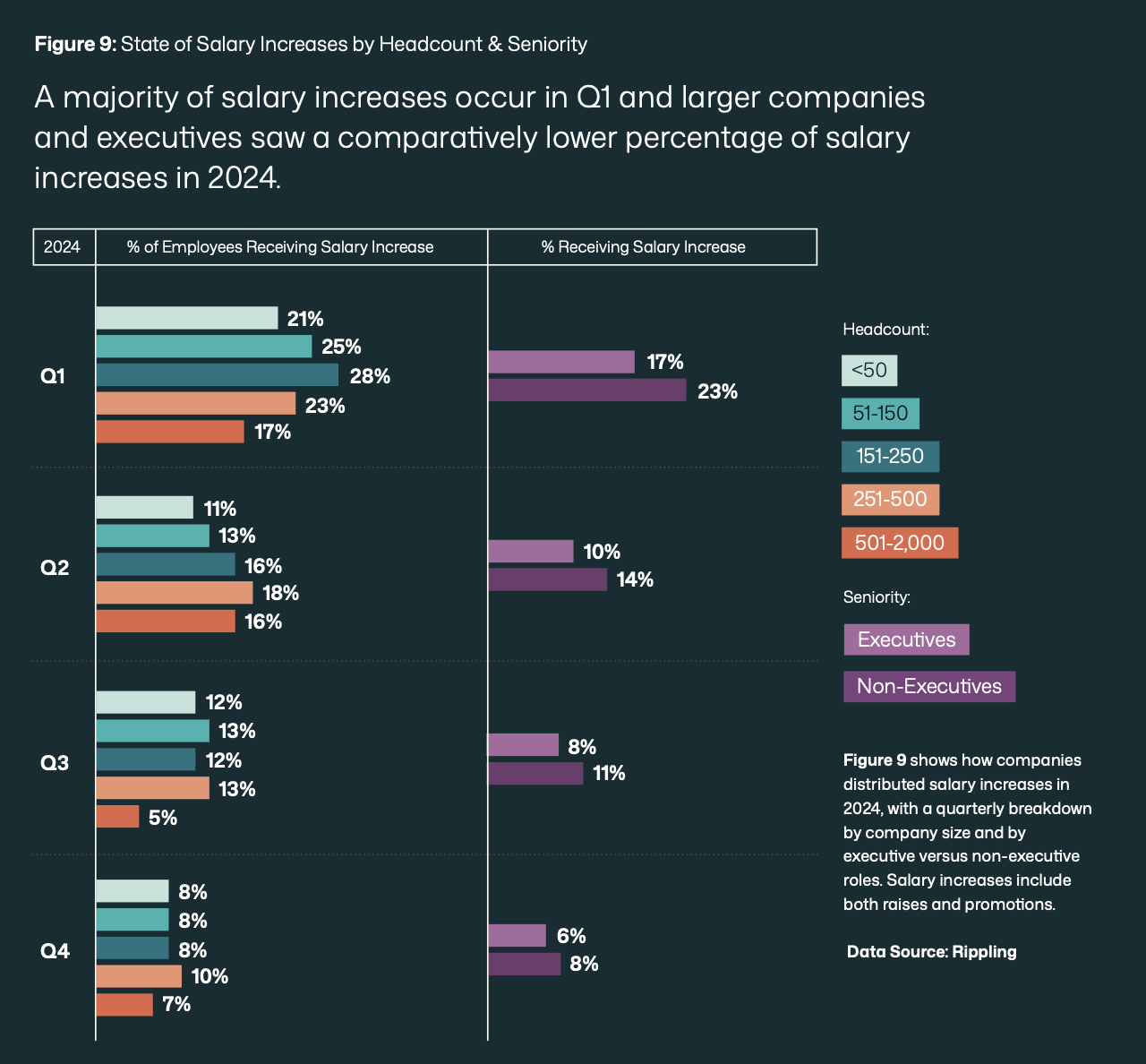Throughout my career as both a startup CFO, finance leader, and investor in early-stage startups, I've observed a striking pattern. Founders are often meticulous about tracking product roadmaps and their cash burn, but often take a surprisingly casual approach to their most valuable asset—their people. While understandable—the pressure to prove product-market fit is all-consuming in a startup's earliest days—this imbalance can quietly undermine the very growth you are working so hard to achieve.
Far and away, your people are the biggest differentiator for your company. This explains why 75% of most companies' total spend goes toward employees—what's known as Total People Investment (TPI). TPI strategically aligns compensation, equity, benefits, and other people costs with your business plan, ensuring your team thrives and, consequently, your company succeeds.
As a founder, it's tempting to dismiss TPI as just another HR buzzword. When you're constantly putting out fires and managing day-to-day crises, another strategic planning session feels like a luxury you can't afford. I understand this reality all too well.
But there are certain realities of operating a startup that are too hard to ignore. Top talent can leave on a dime, hiring for any position can be a massive time and energy suck, and subpar benefits could even damage your startup's reputation. A holistic people strategy is the straightforward solution for effective hiring, optimal retention, and scaling your business up-and-to-the-right.
Rippling recently teamed up with Sequoia and Carta to create an in-depth guide to navigating total people investment strategies. By combining our rich proprietary datasets, we’ve stitched together a comprehensive picture of how businesses are approaching their people in 2025. Things like:
- Which equity structures actually work best in today's competitive market
- The benefits startups can offer that deliver big impact without breaking the bank
- Smart ways to reward your top performers when cash is tight
While the report includes companies with up to 1,000 employees across several different industries, it’s weighted toward emerging and VC-backed companies by design. This means you'll see benchmarks that reflect both your current peers' best practices and those of companies at the scale you're aspiring to reach—giving you actionable insights no matter where you are in your growth journey.
I highly recommend checking out the full report below, which is chock full of data points on hiring, compensation, equity and benefits. In this article, I'm spotlighting the most crucial insights that startup founders need on their radar—breaking everything down into three actionable reasons to invest in TPI. Let's dive in.
Differentiate your startup in a challenging hiring market
Many early-stage founders worry about competing for talent against bigger or better-funded companies. Especially for technical roles, the talent pool is limited and the recruiting field can be fierce. The good news is that smaller startups can actually stand out by leaning into TPI strategies that speak directly to candidate needs.
Sweeten the offer with a 401(k) match
It’s easy to assume that 401(k) matching is just for large enterprises. But smaller companies who offer a match can gain a recruiting edge.

Sequoia data shows that retirement costs make up a larger percentage of companies’ benefits spend as their headcount increases—which means that smaller companies that invest in retirement benefits can differentiate themselves from their competitors and attract top talent. If you can fit a modest match into your runway and burn projections, you’ll position your startup as one that invests in its people’s long-term future.
Use equity strategically
Stock options remain the most common equity vehicle for new hires, but we’re also seeing rising interest in RSUs.

Whichever path you choose, understand that equity tends to evolve with each funding round and as market conditions shift. The key is to balance your equity burn with a cash compensation strategy that fits your growth stage—you don’t want to over-dilute your cap table, nor do you want to skimp on the equity portion if it’s truly pivotal to closing the candidates who will shape your product and culture.
Fine-tune compensation and benefits
Cash compensation (base plus variable pay), makes up the vast majority (80%) of a company’s people spend (figure 1). It helps explain why last year, there was a rise in average salaries across job categories (figure 2), despite ongoing economic uncertainty. Cash is still king after all, and should be a cornerstone of your comp strategy.

However , benefits such as healthcare, wellness programs, and perks can influence a candidate’s decision to join your team or accept a competing offer. Early-stage startups don’t need to replicate big-company benefits, but you do need to show you care about the overall well-being of each employee. This approach signals that you’re building a lasting, people-first culture.
Retain your star talent with a killer compensation strategy
Hiring good people is half the battle. Once they’re on board, you need to keep them engaged, growing, and aligned with your mission. In challenging markets, TPI principles help you stabilize and reward the people you can’t afford to lose.
Utilize performance-based raises and promotions
When it comes to merit cycles, many startups center them in Q1.

Others—especially resourceful or contrarian founders—use off-cycle raises to hold onto high-performers before they start shopping around. And only 26% of companies systematically identify their top performers, which is a missed opportunity to recognize and reward those individuals who truly move the needle.

A performance-based culture is not something that magically materializes; it requires a strong foundational comp strategy with well-designed processes for merit increases, raises, and promotions. Rewarding your top performers is a surefire way to maximize your company’s return on its people investment.
Adil Syed
SVP, GM of Startups, Rippling
Layoffs and economic uncertainty haven’t stopped companies from conducting merit cycles and promotions; in fact, raises can be one of the most direct ways to show employees they’re valued and have a future at your company. Rather than implementing a blanket raise, consider using data (like department performance metrics or external compensation benchmarks) to tailor each increase so you’re investing in the people and roles that matter most to your growth strategy.
Increase efficiency across your org from the get-go
TPI isn’t just about spending more on your people—it’s about spending smart. When your people strategy aligns with your business goals, you cut down on unnecessary spending, eliminate redundant overhead, and solve problems faster.
Align salary spend with managerial leverage
It’s typical for managers to consume a bigger share of the salary budget compared to individual contributors.

Rather than seeing this as a burden, think of it as an investment in the leaders who set the tone for an entire team’s productivity. If managers are underpaid or churning, it creates cascading dysfunction. On the other hand, if they’re happy, well-compensated, and aligned with the company vision, the overall team is more engaged and efficient.
Centralize people data early
When your company is five employees in a garage, spreadsheets might suffice for storing and managing employee data. But once you scale to 50 or 100, having multiple systems for payroll, equity management, performance tracking, and benefits can become an unmanageable tangle.
My recommendation to founders is always this: Get ahead of employee data management before it becomes an emergency. A single, centralized source of truth for employee data becomes the foundation for real-time analytics on your biggest expense and your greatest asset: your employees.
Take your first steps toward a winning TPI strategy
It’s easy to push people decisions aside when you’re caught up in product deadlines or fundraising. But after many years seeing what works—and what doesn’t—I firmly believe that early-stage founders who prioritize their people come out ahead. You’ll attract stronger candidates, retain them longer, and build a culture of performance that fuels growth, even in turbulent markets.
If you want the full spectrum of data on compensation, equity, and benefits (including detailed benchmarks for companies of all sizes), check out the 2025 Guide to Navigating TPI. In it, you’ll find more insights, figures, and frameworks to inform your startup’s next steps.
Remember: You can’t scale your product without scaling your people. Use TPI to make sure you’re doing both in lockstep—and watch your startup thrive as a result.
This blog is based on information available to Rippling as of April 7, 2025.
Disclaimer: Rippling and its affiliates do not provide tax, accounting, or legal advice. This material has been prepared for informational purposes only, and is not intended to provide or be relied on for tax, accounting, or legal advice. You should consult your own tax, accounting, and legal advisors before engaging in any related activities or transactions.










